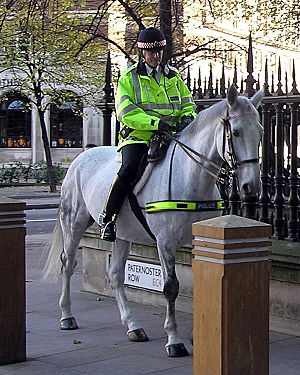Paternoster Row facts for kids
Paternoster Row was a well-known street in the City of London. It was famous for being a major hub for the book trade. Many booksellers and publishers had their shops there. People often said "Paternoster Row" when they meant the book business itself. This street was located near St Paul's Churchyard.
Sadly, the street was badly damaged during World War II by bombs. In 2003, a new area called Paternoster Square was built where the street used to be. This square is now home to the London Stock Exchange. However, a special road sign still stands in the square, showing where Paternoster Row once was.
Contents
The History of Paternoster Row
The name Paternoster Row goes back a long way, even to the 12th century. The street got its name because it was the main place in London where "Paternoster beads" were made. These beads were like early rosary beads. Skilled craftspeople made them for people to use during prayer.
At that time, many monks and friars could not read. They used these beads to help them pray. Instead of reciting 150 psalms, they would say 30 "Paternoster" prayers three times a day. "Paternoster" means "Our Father" in Latin.
Paternoster Row: A Book Publishing Center
For centuries, Paternoster Row was the heart of London's publishing world. Many important printers and booksellers had their businesses there. It was a bustling place where new books were printed, sold, and discussed. Before about 1762, shops in London used signs instead of numbers to identify themselves.
Some of the well-known publishers who had offices on Paternoster Row included:
- Longman and Co. (later Longmans, Green, and Co.) was a very famous publisher.
- Chambers was another important publishing house.
- The Religious Tract Society and The Sunday School Union also had offices there. They published religious books and materials.
- Oxford University Press had a Bible warehouse on the street. It was rebuilt around 1880 after a fire.
- Many other smaller printers and booksellers also called Paternoster Row home.
Other Groups on Paternoster Row
Besides book businesses, other groups also had their offices on Paternoster Row. For example, the Friendly Female Society was located at No. 60. This group helped women in need, specifically "indigent widows and single women of good character." It was managed entirely by ladies.
Paternoster Row in Popular Culture
Paternoster Row has even appeared in television shows!
- The Paternoster Gang is a group of Victorian detectives in the TV series Doctor Who. They are named after the street because their base is located there.
- In the TV series Victoria, an episode called "Young England" features a character who says they live on Paternoster Row. Interestingly, the actress who plays Queen Victoria in that show, Jenna Coleman, also appeared in Doctor Who with the Paternoster Gang!
See also
 In Spanish: Paternoster Row para niños
In Spanish: Paternoster Row para niños



